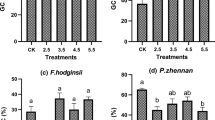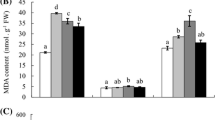Abstract
Acid rain has progressively become more problematic due to increasing concentrations of atmospheric pollution, particularly in China. Mirabilis jalapa L. is an important landscaping ground cover plant with significant resistance to multiple stressors, yet its tolerance to acid stress is unknown. In this study, the effects of acid rain on the growth and numerous physiological indexes of M. jalapa at different growth stages such as plant height, leaf growth, chlorophyll content, and chlorophyll fluorescence were investigated under increasingly acidic conditions of pH 5.6 (control), pH 4.0, pH 3.0, and pH 2.0. We found that the plant height, leaf length, and leaf area of M. jalapa varied significantly across our four treatments (P < 0.05). As the simulated acid rain pH decreased, the plant height, leaf length, and leaf area showed the trend of first increasing before decreasing. In the peak at pH 4.0 treatment, the plant height, leaf length, leaf area, and chlorophyll content were significantly higher than that of the control, pH 3.0 and pH 2.0 (P < 0.05). There are significant differences in chlorophyll fluorescence parameters under different treatments (P < 0.05). The actual photochemical efficiency (ΦPSII) and apparent electron transfer rate (ETR) of the leaves of M. jalapa in the control group, pH 4.0 and 3.0 acid rain stress were significantly higher than that under pH 2.0 stress, while the chemical quenching coefficient (qN) was lower. Chlorophyll fluorescence parameters under control and pH 3.0 treatments were different but not significant (P > 0.05), indicating that M. jalapa seedlings under pH 4.0–3.0 acid rain treatments had higher photorespiration ability. Whereas M. jalapa, under severe stress pH 2.0, increased heat dissipation capacity by absorbing the photorespiration ability. We conclude that acidic conditions of pH of 3.0 were the threshold limit, and acid rain below this value could potentially have a detrimental effect on actual photochemical efficiency. M. jalapa had better adaptability under the decreased acidic conditions, rain concentration pH 4.0 to 3.0, which promoted its growth.



Similar content being viewed by others
Data availability statement
The data used to support the findings of this study are available from the corresponding author upon request.
References
Bayaer T, Parinaz R-B, Yusaku G (2015) Estimating chlorophyll content and photochemical yield of photosystem II (ΦPSII) using solar-induced chlorophyll fluorescence measurements at different growing stages of attached leaves. J Exp Bot 66:5595–5603
Bruno SS, Silva F, Aristea LSA, Joao AA, Ericka MA, Eldo FA, AguiarRosane AM (2006) Effects of simulated acid rain on the foliar micromorphology and anatomy of tree tropical species. Environ Exp Bot 58:158–168
Chen X, Hu XH, Xiao YA, Xie Q, Wang CX, Li Y, Dei WH (2008) Floral syndrome and breeding system of Mirabilis jalapa L. Chin J Ecol 27:1653–1658
Chen S, Dong L, Yilita FYU, Chen J (2019a) Chlorophyll fluorescence response and nutrient distribution of Elaeocarpus glabripetalus seedlings with simulated acid rain. J Zhejiang A & F Univ 36:26–33
Chen WS, Chu JF, Lv ZH, Huang XS, Xu BY, Qiu DL (2019b) Dynamic changes in chlorophyll content and chlorophyll fluorescence parameters of leaf of Lycopersicon esculentum after simulated acid rain treatment. J Plant Resour Environ 28:108–116
Dong LL, Li YX, Quan QM, Fan ZL (2013) Photosynthetic characteristics of traditional Chinese medicine Sambucus chinensis Lind. Acta causa sinica 21:816–820
Fu XP, Tian DL, Huang ZY (2006) Effects of simulated acid rain on phytomorphology. J Zhejiang for Coll 23:521–526
Gao XY, Dai JH, Zhang MQ (2018) Responses of variations of plant ornamental period to climate change in the west suburbs of Beijing from 1965–2014. Geogr Res 37:2420–2432
Gao YF, Rong LP, Zhao DH, Zhang JQ, Chen JS (2020) Effects of simulated acid rain on the photosynthetic physiology of Acer ginnala seedlings. Can J for Res 51:1–7
Gimeno L, Teso TD, Bourhim S (2001) How effective has been the reduction of SO2 emissions on the effect of acid rain on ecosystems? Sci Total Environ 275:63–70
Guenni O, Romero E, Guédez Y (2018) Influence of low light intensity on growth and biomass allocation, leaf photosynthesis and canopy radiation interception and use in two forage species of Centrosema (DC.) Benth. Grass Forage Sci 73:967–978
Haenel S, Tielboerger K (2015) Phenotypic response of plants to simulated climate change in a long-term rain-manipulation experiment: a multi-species study. Oecologia 177:1015–1024
Hao T, Zhu Y, Ding X, Jin H, Zhang H, Jizh YU (2014) Effects of high temperature stress in rhizosphere on growth, leaf photosynthetic and chlorophyll fluorescence parameters of five cucurbit crops. J Plant Resour Environ 23:65–73
Hidri R, Barea JM, Mahmoud MB, Abdelly C, Azcón R (2016) Impact of microbial inoculation on biomass accumulation by sulla carnosa provenances, and in regulating nutrition, physiological and antioxidant activities of this species under non-saline and saline conditions. J Plant Physiol 201:28–41
Ilomuanya C, Farokhi S, Nekahi A (2019) Acid rain pollution effect on the electric field distribution of a glass insulator. In: IEEE international conferences, pp 1–25
Iummato MM, Fassiano A, Graziano M, Afonso M, Juárez NB (2019) Effect of glyphosate on the growth, morphology, ultrastructure and metabolism of Scenedesmus Vacuolatus. Ecotoxicol Environ Saf 172:471–479
Khan MR, Khan MW (2010) Effects of simulated acid rain and root-knot nematode on tomato. Plant Pathol 43:41–49
Larssen T, Lydersen E, Tang D (2006) Acid rain in China. Environ Sci Technol 40:418–425
Li PM, Gao HY, Strasser RJ (2005) Application of the fast chlorophyll fluorescence induction dynamics analysis in photosynthesis study. Acta Photophysiologica Sinica 31:559
Li Y, Wang YQ, Zhang WQ (2021) Impact of simulated acid rain on the composition of soil microbial communities and soil respiration in typical subtropical forests in Southwest China. Ecotoxicol Environ Saf 215:112152
Liang J, Mai BR, Zheng YF, Li L, Wu RJ (2008) Effects of simulated acid rain on the growth, yield and quality of rape. Acta Ecol Sin 28:274–283
Luo HX, Song T, Zhang ZQ, Dai QW, Huang HD, Huang YB, Mao SL (2020) Study on the characteristics of acid rain in Nanchong City from 2009 to 2017. Environ Monit China 2:82–87
Mao XY, Lou YX, Dai Chao YuF, Liang JY, Lü ZQ (2020) Effects of cadmium pollution and acid rain on photosynthetic characteristics of Morus alba seedling sexes. Chin J App Environ Biol 143:122–129
Masamichi T, Zhaozhong F, Tatyana AM, Olga VK, Olga VS, Larisa VA, Roland KJH, Nik MAM, Hiroyuki S (2020) Air pollution monitoring and tree and forest decline in East Asia: a review. Sci Total Environ 742:140288
Pignattelli S, Broccoli A, Piccardo M, Terlizzi A, Renzi M (2021) Effects of polyethylene terephthalate (pet) microplastics and acid rain on physiology and growth of Lepidium sativum. Environ Pollut 282:116997
Qiu D, Liu X (2002) Effects of simulated acid rain on chloroplast activity in Dimorcarpus longana lour. cv. wulongling leaves. Chin J Appl Ecol 13:1559–1562
Ruuhola T, Rantala LM, Neuvonen S, Yang SY, Rantala MJ (2009) Effects of long-term simulated acid rain on a plant-herbivore interaction. Basic Appl Ecol 10:589–596
Santos N, Arruda E, Gladys FAMPNA, Oliveira AFMD (2020) Assessing the effects of water quality on leaf morphoanatomy, ultrastructure and photosynthetic pigment content of Salvinia auriculata aubl. (salviniaceae). Ecotoxicol Environ Saf 190:110061
Schlemmer MR, Francis DD, Shanahan JF, Schepers JS (2005) Remotely measuring chlorophyll content in corn leaves with differing nitrogen levels and relative water content. Agron J 97:106–112
Thwe AA, Kasemsap P, Vercambre G, Gay F, Gautier H (2020) Impact of red and blue nets on physiological and morphological traits, fruit yield and quality of tomato (Solanum lycopersicum mill.). Sci Hortic 264:109185
Tong GH, Liang HL (2005) Effects of simulated acid rain and its acidified soil on soluble sugar and nitrogen contents of wheat seedlings. Chin J Appl Ecol 16:1487–1492
Wang Y, Nii N (2015) Changes in chlorophyll, ribulose bisphosphate carboxylase-oxygenase, glycine betaine content, photosynthesis and transpiration in leaves during salt stress. J Hortic Sci Biotechnol 75:623–627
Xu GF, Liu MJ, Li YL (2008) Invasion characteristics and invasion risk assessment of Mirabilis jalapa. Acta Botan Boreali-Occiden Sin 28:4765–4770
Xue SG, Zhu F, Ye S, Wang J, Wu XE (2011) Physiological response of Mirabilis jalapa Linn. to lead stress by FTIR Spectroscopy. Acta Ecol Sin 31:6143–6148
Zhang GS, Gu SY, Hu J, Zhou Q (2007) Response of thirty species of herbaceous ornamental plants to simulated acid rain. Chin J Eco-Agric 15:104–107
Zheng LT, Tian SU, Liu XY, Yin F, Guo C, Tuo B, Yan ER (2018) Species, functional, structural diversity of typical plant communities and their responses to environmental factors in Miao Archipelago, China. Chin J of Appl Eco 29:343–351
Acknowledgements
The authors would like to express their gratitude to EditSprings (https://www.editsprings.com/) for the expert linguistic services provided.
Funding
This study was supported by the Young Teachers Scientific Research Grant Project of China West Normal University (22KB004) and Youth Foundation Specialization of China West Normal University (18D049).
Author information
Authors and Affiliations
Corresponding author
Ethics declarations
Conflict of interest
The authors declare that they have no conflict of interest. This article does not contain any studies with human participants or animals performed by any of the authors. Informed consent was obtained from all individual participants included in the study.
Additional information
Communicated by C. L. Cespedes.
Publisher's Note
Springer Nature remains neutral with regard to jurisdictional claims in published maps and institutional affiliations.
Rights and permissions
Springer Nature or its licensor (e.g. a society or other partner) holds exclusive rights to this article under a publishing agreement with the author(s) or other rightsholder(s); author self-archiving of the accepted manuscript version of this article is solely governed by the terms of such publishing agreement and applicable law.
About this article
Cite this article
Chen, Ly., Wang, L., Wang, Hy. et al. Characterising the influence of acid rain on the growth and physiological characteristics of Mirabilis jalapa Linn. in southern China. Acta Physiol Plant 45, 5 (2023). https://doi.org/10.1007/s11738-022-03490-8
Received:
Revised:
Accepted:
Published:
DOI: https://doi.org/10.1007/s11738-022-03490-8




